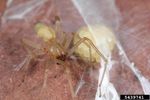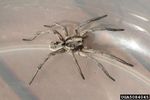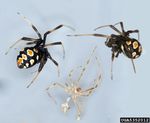Spiders of Medical Concern in Virginia
←
→
Page content transcription
If your browser does not render page correctly, please read the page content below
Spiders of Medical Concern in Virginia
Authored by Theresa A. Dellinger, Diagnostician, and Eric Day, Insect ID Lab Manager,
Insect Identification Lab, Department of Entomology, Virginia Tech
Virginia that do produce more severe symptoms
Introduction requiring medical attention.
Several species of spiders found in Virginia have
fearsome reputations for painful bites resulting in
life-threatening complications. All spiders use Important Note
venom to kill their prey, but many spiders are not There is always the possibility that spider venom
nearly as aggressive or dangerous as they are from a normally harmless species may cause severe
presented in urban legends and the media. Spider symptoms in very sensitive individuals, especially in
identification requires specialized knowledge and the young, the old, or the immunocompromised. If a
sufficient magnification. Many harmless species are sensitive person is bitten by a spider, or if the spider
mistakenly identified as being dangerous due to a is thought to be a species known to be of medical
lack of a lack of training or a good microscope. concern, apply ice to the bite, elevate the wound, and
seek prompt medical attention. Whenever possible,
Even medical doctors cannot diagnose a wound as a kill and take the spider to the physician for positive
spider bite based solely on the appearance of the identification. An expert may be able tell if it is a
wound. A wound can only be diagnosed definitively spider of medical concern or not even if the spider is
as resulting from a spider bite if a spider is observed smashed.
in the act of biting. Many necrotic “spider bites” are
actually the result of other causes, such as bacterial
infection or other insect bites. Given the frequency
Spiders with Potentially
of incorrect identifications, misdiagnosed spider Harmful Venom Found in
bites, and media hype about venomous spiders, it’s
no wonder that so many people are terrified of Virginia
spiders. The purpose of this fact sheet is to describe
some of the spider species in Virginia that people Widow Spiders
commonly inquire about as being dangerous. This (Family Theridiidae, Latrodectus spp.) Both the
information may help address a homeowner’s northern (L. variolus Walckenaer) and the southern
concern about personal safety and possibly eliminate (L. mactans F.) black widow spiders are commonly
a suspect spider as one of the more medically found in Virginia. Female L. variolus and L.
dangerous species. mactans have shiny black bodies with red markings
on the underside of the abdomen. Female L. mactans
Most spider species are not aggressive or considered usually have a complete hourglass with both
to be dangerous. Spider bites typically occur when a triangles connected in the middle and an additional
spider is handled roughly or trapped and pressed red spot near the spinnerets at the dorsal tip of the
against the skin. Even if a spider does bite someone, abdomen (Fig. 1). Female L. variolus tend to lack a
it may not inject any, or only very little, venom into complete hourglass and may instead have two red
the bite. For many people, spider bites are often no bars on both the top and the underside of the
worse than a bee sting with localized pain, swelling, abdomen. Immature L. variolus and L. mactans of
and sometimes itching of the skin. Most spider bites either sex have banded legs and, on the abdomen,
can be treated with just ice and a pain reliever. white patches with red or orange dots. Mature males
However, there are a few species of spiders found in of both species retain the immature coloration andare about half the size of the female but with often golden brown. There are no stripes or bands on
proportionally longer legs. Adult females measure the legs. The fiddle marking is usually dark brown
about 1.25 cm (0.5 inch) with a leg span of about 4.5 or black, with the neck of the fiddle pointing towards
cm (1.5 inches). Adult males are much smaller, with the abdomen (Fig. 4). Hairs on the body are fine, not
a leg span of about 1.25 cm (0.5 inch). Immatures coarse, and the fiddle pattern is often shiny. The
and males of both species are not considered to be of body measures 8-10 mm long (about 0.4 inch).
medical concern (Figure 2). Wolf, nursery web, and funnel weaver spiders are
often mistaken for brown recluse spiders. Unlike
these other spiders, brown recluse spiders never have
stripes or bands on their legs, or spots or multiple
stripes on the abdomen.
Figure 1. Female southern black widow spider
showing the typical red hourglass marking on the
underside of the abdomen. (Ed Freytag, City of New
Orleans, Bugwood.org)
Figure 3. Brown recluse spider. (Ed Freytag, City of
New Orleans, Bugwood.org)
Brown recluse spiders have six eyes arranged in
three groups of two eyes each, with space between
each pair of eyes (Fig. 4). This is an excellent way to
identify a brown recluse spider as most spiders have
eight eyes arranged in two rows, but it does require
proper magnification to see clearly.
Figure 2. Immature southern black widow spiders.
(David Cappaert, Bugwood.org)
Brown Recluse Spider
(Family Sicariidae, Loxosceles reclusa Gertsch &
Mulaik) Brown recluse spiders belong to a group of
spiders commonly known as violin spiders or
fiddlebacks, named so because of a characteristic
fiddle-shaped pattern on their head region (never on Figure 4. Closeup of brown recluse spider showing
the characteristic eye pattern and the typical “fiddle
the abdomen) (Figs. 3 and 4). Brown recluse spiders
marking” behind the eyes. (Lisa Ames, University of
range in color from tan to dark brown, but they are Georgia, Bugwood.org)
Virginia Cooperative Extension 3Cheiracanthium mildei tends to be found inside
Brown recluse spiders are found primarily in the man-made structures, often on walls and ceilings,
Midwest and south-central states. Its natural range while C. inclusum occurs outdoors on foliage and in
reaches to the very tip of southwestern Virginia, but grasses.
isolated populations have been confirmed in several
locations across Virginia. These small, isolated
introductions are likely the result of household
goods or firewood transported from the brown
recluse’s natural range into areas where it was not
previously known to occur. The spider commonly
lives in basements and garages of houses and often
hides behind boards and boxes. It does not make
webs out in the open. Populations of brown recluse
spiders can be very high in infested buildings.
Despite alarming stories in the media, brown recluse
spiders seldom bite and the severity of the bite
frequently varies from person to person (Vetter Fig. 5. Yellow sac spider, Cheiracanthium inclusum.
2013). Symptoms may range from no harm at all to a (Joseph Berger, Bugwood.org)
very severe reaction. Often the initial bite is painless,
followed by a systemic reaction within 24-36 hours Both species are frequently found in or near their
with restlessness, fever, chills, nausea, weakness, silken tube or “sac” that they use as a protective
and joint pain. Tissue death may occur at the bite retreat during the day (Fig. 6), but these spiders are
wound and the skin may slough off. In some severe nocturnal ambush hunters and do not spin a web to
cases, a wound may develop that lasts several trap their prey. Bites are generally mild and self-
months. More severe symptoms are seen in the very limiting in severity; they usually heal in a few weeks
young, the very old, or in the immunocompromised. if the wound is kept clean and free of secondary
However, many people live in areas where there are infection. Yellow sac spiders do not deserve the
native populations of brown recluse spiders, often in reputation they have gained as having dangerously
very high densities, and they are rarely bitten or have toxic venom. A medical review of verified
only very mild reactions after being bitten. Cheiracanthium spp. bites indicated that venom
from these spiders does not typically result in large
necrotic lesions despite initial reports by other
In Virginia, But Not researchers (Vetter et al. 2006).
Deserving Their
Reputation
Yellow sac spiders
[Family Miturgidae, Cheiracanthium inclusum
(Hentz) and C. mildei Koch]
Cheiracanthium inclusum is native to the United
States, while C. mildei was introduced from Europe.
Both species are similar in size (4-10 mm or 0.2-0.4
inch) and coloration (light yellow or beige with
darker brown tips on the legs and mouthparts) (Fig.
5). Cheiracanthium mildei may have a greenish tinge
Fig. 6. Female yellow sac spider, Cheiracanthium
in color. Both species have a darker midline stripe inclusum, with eggs in her silken retreat. (Joseph
that begins behind the head but does not completely Berger, Bugwood.org)
reach the tip of the abdomen (Fig. 5).
Virginia Cooperative Extension 4Not Known to Occur in Wolf spiders
(Family Lycosidae) Wolf spiders are large, hairy,
Virginia active predators with long legs. They are typically
colored brown with various patterns of darker stripes
Hobo spider or mottling on the body and the legs (Fig. 8). Some
[Family Agelenidae, Eratigena agrestis species in the genus Hogna are quite large,
(Walckenaer)] This species is only found in the measuring 18-35 mm (about 2-3.5 in) in size. These
Pacific Northwest and does not occur in other parts are ground dwelling spiders that hunt their prey and
of the United States. Despite its reputation, there is do not spin webs. Females carry their egg sac
no strong scientific evidence that this spider is of attached to their spinnerets at the tip of their
medical importance. Hobo spiders are not aggressive abdomen.
and their venom does not appear to cause necrotic
lesions as once thought (Vetter and Isbister 2004).
Species Often Mistaken as
Being Dangerous
Jumping spiders
(Family Salticidae) These are active, hairy predators
with large conspicuous eyes and often bold
coloration (Fig. 7). They do not spin webs but hunt
their prey, often leaping on to them with surprising
speed. Jumping spiders are commonly found Figure 8. Wolf spider. (Whitney Cranshaw, Colorado
outdoors on plants and manmade structures. State University, Bugwood.org)
Nursery web spiders
(Family Pisauridae) These are similar in appearance
to the wolf spiders with long legs, hairy bodies, and
brown stripes or mottled coloration (Fig. 9). Females
are often seen carrying their egg sac with their
mouthparts.
Funnel Weavers
(Family Agelenidae) These spiders spin webs with a
tube or “funnel” retreat, often on grasses, shrubs, or
in corners of porches and other structures (Fig. 10).
They wait in the silken funnel for prey to walk
across the web, then ambush the prey and drag it
back into the funnel. Do not confuse funnel weavers
with the infamous Sydney funnel-web spider [Atrax
robustus O.P.-Cambridge (Family Hexathelidae)],
which occurs in Australia and has never been found
in North America.
Figure 7. Jumping spider. (David Cappaert,
Bugwood.org)
Virginia Cooperative Extension 5Figure 11. Cobweb weaver spider, Steatoda
triangulosa. (Joseph Berger, Bugwood.org)
Avoiding Spider Bites
Some simple precautions can prevent many spider
bites, especially in areas known to have populations
of potentially harmful spiders. Limit the entry of
Figure 9. Nursery web spider. (David Cappaert, spiders into the house by checking that all screens
Bugwood.org) and weather stripping around doors and windows are
secure. Seal all cracks and crevices in the
foundation, attic, around pipes, etc. as well. Clear
clutter and junk from in and around the home to
eliminate hiding places for spiders and their
invertebrate prey. Don’t stack firewood beside the
house for the same reasons. Clean closets, attics,
basements, and other storage areas regularly to
discourage spiders from taking up residence in them.
Vacuum regularly behind and underneath furniture
and large appliances. Consider removing bed skirts,
furniture slipcovers that reach the floor, and long
draperies that may conceal spiders.
Wear long sleeves and gloves when moving
firewood or other items that may harbor spiders,
such as cardboard boxes, stored papers, or anything
Figure 10. Nursery web spider. (David Cappaert, left undisturbed for a length of time. Long sleeves
Bugwood.org) and gloves are also a good idea when doing yard
work. Shake out clothing, towels, or bedding before
House Spiders use. Also shake out your shoes or gloves before
(Family Theridiidae) The common house spider putting them on, especially if they have been left
[Parasteatoda tepidariorum (Koch)] and spiders in outside. Spiders cannot bite through fabric, but they
the genus Steatoda are sometimes mistaken for black can bite if trapped or pressed against the skin.
widow spiders (Lactrodectus spp.) (Fig. 11). While
they belong to the same family as the widow spiders, Sticky traps are effective in monitoring spider
they are not considered dangerous. In fact, the false populations and can help reduce their numbers
black widow spider [Steatoda grossa (Koch)] is inside buildings. Individual spiders can be killed
actually a specialist predator of black widow spiders. with a fly swatter or with an aerosol insecticide
spray. Insecticides with residual activity can be
Virginia Cooperative Extension 6applied for spider control, but sealing any entry points into the home and removing potential hiding places is a more effective strategy for controlling spiders. Revised Theresa A. Dellinger, February 7, 2020. References Hannum, C., Jr. and D. M. Miller. 2012. Widow Spiders, 444-422. Accessed Feb 4, 2020. http://pubs.ext.vt.edu/444/444-422/444-422.html. Vetter, R. S. 2013. Myth of the Brown Recluse: Fact, Fear and Loathing. Accessed Feb 4, 2020. http://spiders.ucr.edu/myth-brown-recluse-fact- fear-and-loathing. Vetter, R. S. and G. K. Isbister. 2004. Do hobo spider bites cause dermonecrotic injuries? Annals Emerg Med 44:605-607. Accessed Feb 4, 2020 at https://utahpests.usu.edu/uppdl/files- ou/ezplug/uploads/Hobo%20Spider%20Dermone crotic%20Lesions.pdf. Vetter, R. S., G. K. Isbister, S. P. Bush, and L. J. Boutin. 2006. Verified bites by yellow sac spiders (Genus Cheiracantium) in the United States and Australia: where is the necrosis? Am J Trop Med Hyg 74(6): 1043-1048. Virginia Cooperative Extension programs and employment are open to all, regardless of age, color, disability, gender, gender identity, gender expression, national origin, political affiliation, race, religion, sexual orientation, genetic information, veteran status, or any other basis protected by law. An equal opportunity/affirmative action employer. Issued in furtherance of Cooperative Extension work, Virginia Polytechnic Institute and State University, Virginia State University, and the U.S. Department of Agriculture cooperating. Edwin J. Jones, Director, Virginia Cooperative Extension, Virginia Tech, Blacksburg; M. Ray McKinnie, Administrator, 1890 Extension Program, Virginia State University, Petersburg. 2020 ENTO-73NP (ENTO-346NP) Virginia Cooperative Extension 7
You can also read



























































